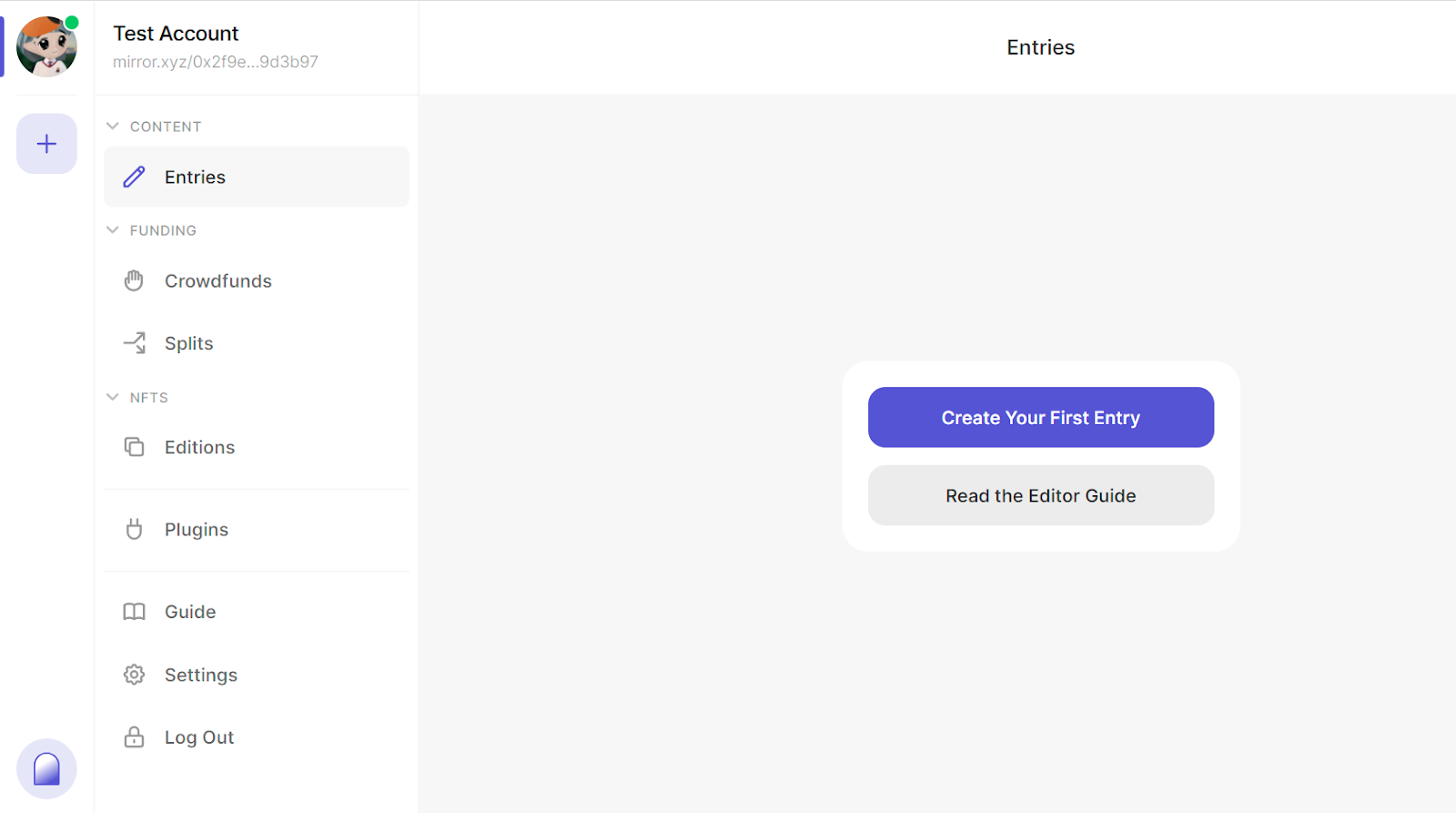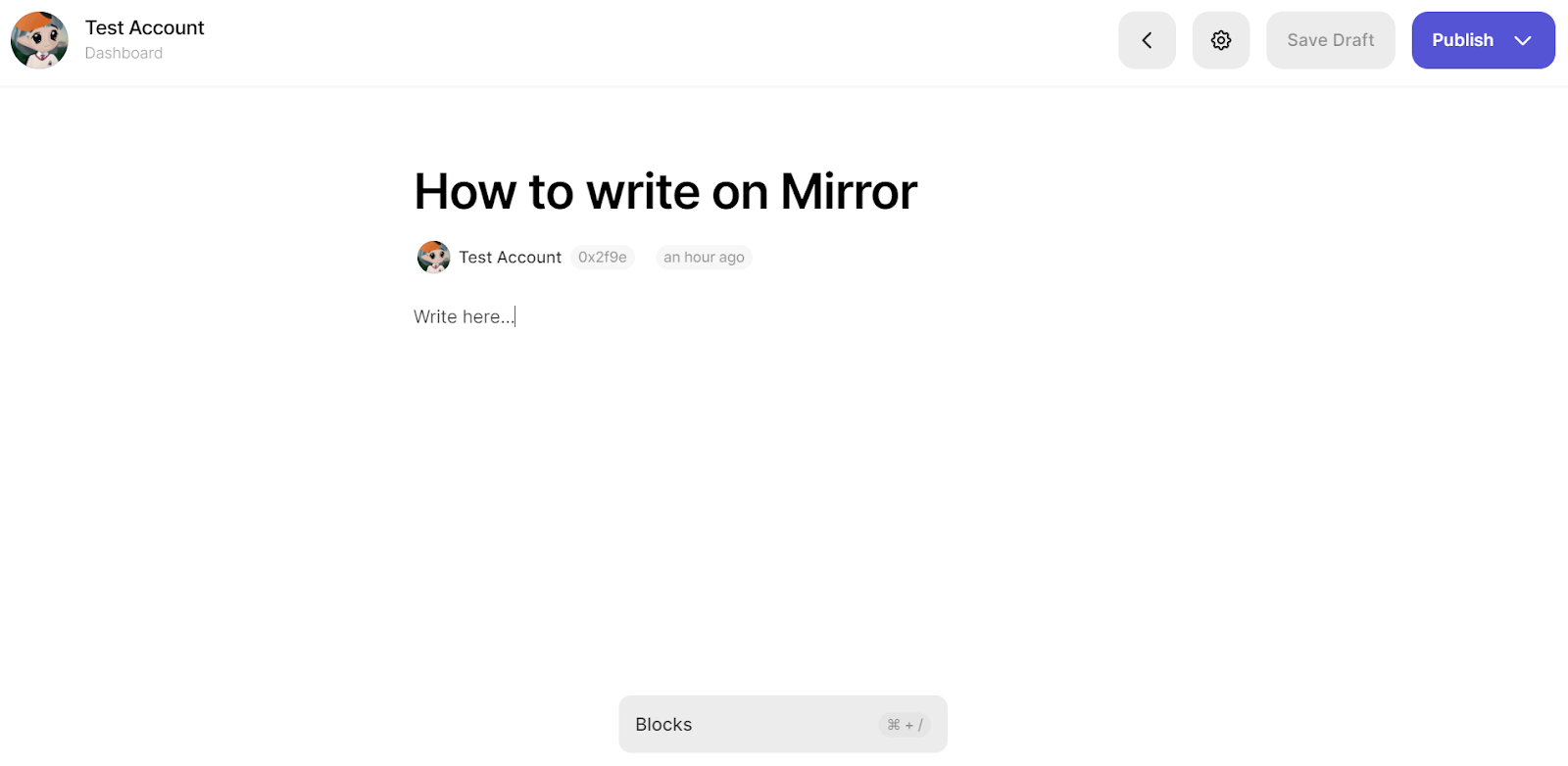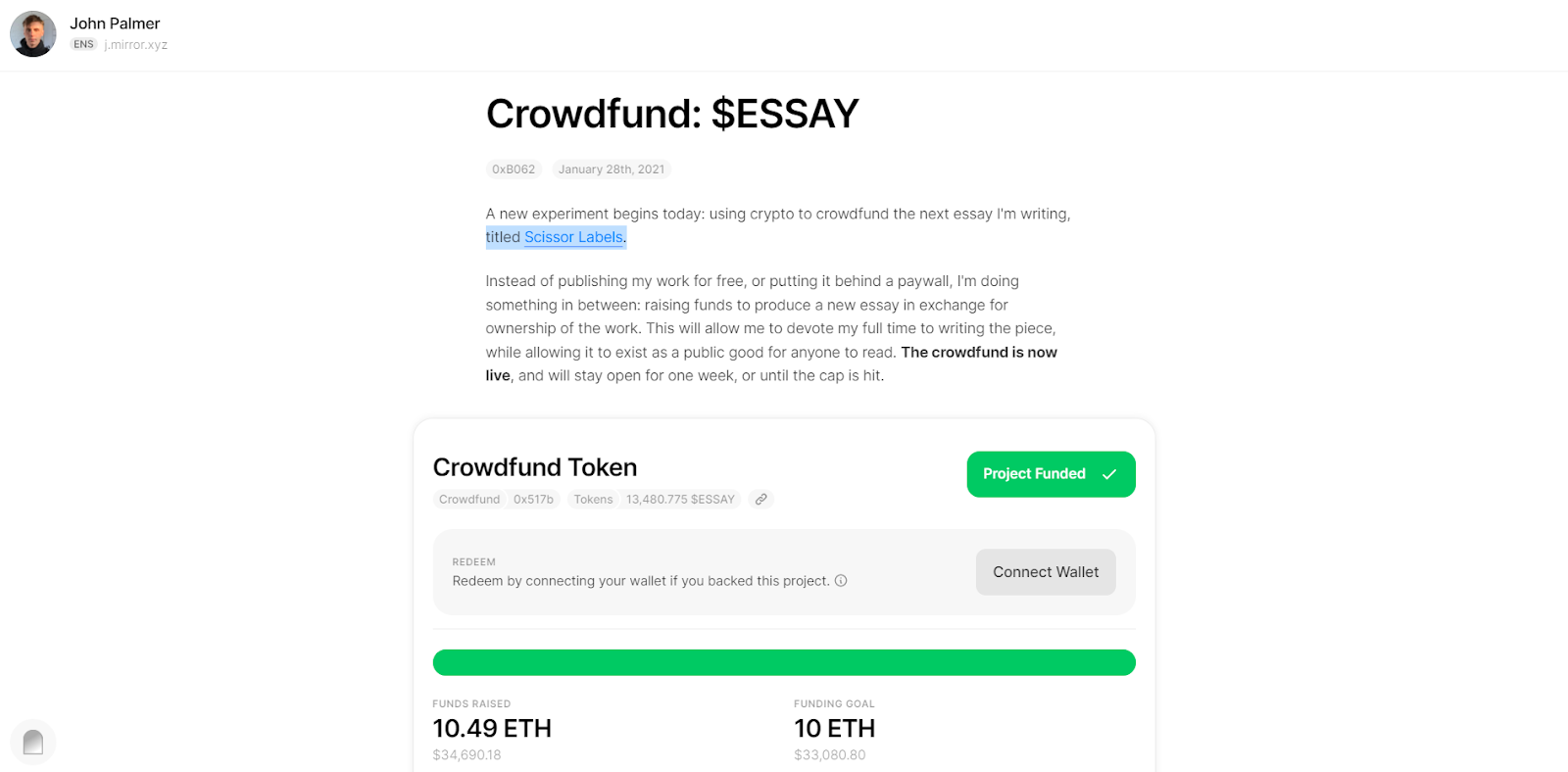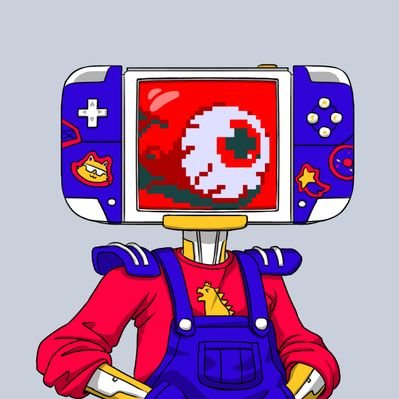How to build a web3 publication

 Cartesi - Build app-specific rollups with Web2 tooling!
Cartesi - Build app-specific rollups with Web2 tooling!
Dear Bankless Nation,
What was the original sin of the internet?
We didn’t add a money protocol.
Marc Andreessen put it this way:
“Because we were unable to build payments into the browser… as a consequence, that is why the internet today…is predominantly based on advertising.”
Web2 publishers are in the business of selling eyeballs.
But Web3 can fundamentally change the business model of the internet. We can bake value mechanisms directly into a publication.
What if writers could sell their articles as NFTs, allowing their biggest fans to support them and become early investors in their work?
What if readers could send tips directly and split them with collaborators in a few clicks—no banks or credit cards required.
What if you could send tokens to your readers as a reward and build a vibrant community? Or crowdfund a new initiative directly from your writing?
This is the future of publishing in the internet of value.
And this isn’t fantasy.
It’s possible today.
Mirror is the major web3-native publication making strides in this direction.
Here’s the ultimate guide to becoming a web3 publisher.
- RSA
Mirror is a Web3 publishing platform that offers a suite of web3-native tools to empower writers and creatives.
This Bankless tactic will demonstrate how to start publishing on Mirror and how you can use the platform’s financial tools, e.g. crowdfunds, in your posts to become a self-sustainable, independent publisher.
- Goal: Learn how to publish through Mirror
- Skill: Beginner
- Effort: 15 minutes
- ROI: Becoming an independent publisher!
Welcome to Mirror

Web3-native writing platform.
Decentralized blogging app.
An “essential Web3 toolkit for sharing and funding anything.”
These are a few of the ways I’ve seen Mirror described. The variety of descriptions speaks to how Mirror is best understood as a multi-dimensional suite of tools for crypto creatives.
Generally speaking, Mirror is Ethereum’s first great alternative to mainstream publishing avenues like Medium and WordPress. But Mirror is also much more than just a place for publishing writings, as the project offers a range of functionalities. These features currently include:
- Mirror Editor — This text editor and publisher lets creators build posts with media blocks, e.g. images, and cryptoeconomic blocks, e.g. embedded NFT auctions.
- Entry NFTs — Posts on Mirror can be minted as 1/1 NFTs, i.e. memorabilia for collectors and fans that can help artists and writers make a living or fund further projects.
- Crowdfunding — Mirror lets users create a crowdfund block, i.e. an Ethereum smart contract for raising funds, that can be embedded alongside text and media blocks like videos. Contributors receive an ERC20 token that represents their participation and ownership in the project.
- Splits — A split is a smart contract-powered payments routing mechanism that lets creators allocate funds from auctions or donations to “collaborators, the people that have inspired you, or to donate proceeds from your work.”
- Editions — A functionality for creating a “limited supply of identical NFTs at a fixed price,” e.g. 100 pieces of crypto-art.
- Entry Editions — Creators can use this system to mint their Mirror posts as limited-edition NFTs instead of 1/1s.
- Tokens — A streamlined ERC20 minter that makes it easy for creatives to kickstart communities and distribute governance tokens.
Even though Mirror may be young now and will add even more features in the future, the platform is already versatile.
At JPG, an NFT curation platform I contribute to, we’ve used our Mirror as a straightforward Web3 alternative to Medium for posting official announcements and so forth. However, the platform is wide open for all sorts of different use cases, a handful of which I’ll highlight below.
Examples of Mirror in action

EIP-1559 Supporter Series
Via OpenSea:
“As an experiment in providing cultural prestige & economic upside to EIP-1559 Contributors, a limited series of EIP-1559 NFTs was issued by Stateful Works. The art for this series was created by _kitteh, who has previously created artworks centered on Public Goods recognition. All proceeds from NFT minting were trustlessly forwarded to EIP-1559 contributors using a split contract.”
NFT Value Capture Equation
In February 2021, the first major NFT bull market was just beginning to kick into gear. Droves of newcomers were rushing in to make sense of the scene. Then, a recurring Bankless Contributor, Cooper Turley, published his research report NFT Value Capture Equation as a post and an NFT through Mirror.

The report was super informative, and it was also one of the first great “the medium is the message” demonstrations of what Mirror can do.
The 1/1 NFT Edition, ValueEssay, sold for 3.33 ETH!
UKR Sovereignty
In late Feb. 2022, Russia launched a full-scale invasion of Ukraine, which prompted people all around the world to start looking for ways to help in the defense of Ukraine. Jack Butcher (visualizevalue.eth) turned to Mirror to launch a crowdfunding campaign, with the proceeds of the NFT sales all going to aid Ukraine via endaoment.org.
The fundraise sold 172 editions at .1 ETH, raising over 17 ETH for Ukraine.
BURN ALPHA novel
In April 2021, artist Emily Segal used Mirror to crowdfund her novel BURN ALPHA. Purchasers of Segal’s experimental NFT received $NOVEL tokens in exchange for their ETH. Also, collectors received different perks according to various NFT tiers that Segal had set up; for example, “tier two” participants received the right to claim a limited-edition hardcover copy and limited-edition merch.
How Mirror works
Under the hood, Mirror permanently stores user content in Arweave, a decentralized data storage protocol. This storage has been extremely inexpensive to date, so Mirror covers the costs, meaning users can enjoy free publishing.
Moreover, there’s no email-password signup when it comes to Mirror, which instead uses the “Sign-in with Ethereum style.” The platform is also trustless, insofar as publishing and verifying content works independently of the Mirror team; users sign their posts with a non-Ethereum keypair that is stored in Arweave and signed with the writer’s Ethereum address, which makes independent verification possible.
When Mirror launched in early 2021, the platform was invite-only and new members arrived via the $WRITE Race, a community vote system that steadily onboarded new writers. However, in Oct. 2021 the Mirror team opened up the platform for use by anyone with an Ethereum address.
How to use Mirror

Go to Mirror
Head over to mirror.xyz/dashboard when you’re ready. You’ll need an Ethereum address (MetaMask, WalletConnect, and Coinbase Wallet are supported) to get started. Press “Connect Wallet,” choose your wallet option, and then press “Remember Me” to let Mirror remember your account.
Get started
Once you’ve signed in to the main Mirror dashboard, you’ll be prompted to supply a Name and Bio for your new account.
Provide this information and then press “Continue.” On the ensuing page, you can add a profile picture and cover image. After that, you’ll be given the option to verify your identity via Twitter and to link an Ethereum Name Service (ENS) domain to your Mirror account.
Composing an entry

In the Entries section of the dashboard, press “Create Your First Entry.” This brings you to the Mirror Editor, which uses plain text and Markdown for formatting. You can then click the “Import Entry” button to import a post from Medium or Substack, or you can simply start composing a new post from scratch.
Once your cursor is in the body of the Editor, you’ll see a button that reads “Blocks.” You can use this to add section headings, images, bullet points, blockquotes, code snippets, crowdfunds, auctions, editions, splits, and NFT previews.
After you’ve composed the body of your post and have it prepared to your liking, you can use the Settings menu (click on the small gear symbol in the upper right of the Mirror dashboard) to add a cover image and finalize your metadata details. When everything’s set up, press the “Publish” button.
You’ll be given the option to mint the post as an NFT by checking a box, though you don’t have to!
Press “Publish” again to complete the publication process, and then your post will be live and you’ll have a Mirror link you can share.
Setting up economic blocks
If you’re interested in using one of Mirror’s economic blocks like an auction or a crowdfund, the flow works like so:
- Click on your desired block in the Mirror dashboard
- Set up the basic details
- Plug the finished block into an Entry using the aforementioned “Blocks” button in the Mirror Editor
- Publish your post and share it around to spread the word

For example, if you’re keen to use Mirror to launch a crowdfund for a project or cause near to your heart, you’d have to go in and set up your funding goals, your token parameters, your project story, and more. Once your crowdfund block is finished and published in an entry, it looks like the “Crowdfund Token” section in the post above.
Zooming out
Mirror is an empowering “do it yourself” publishing suite for Web3 creatives.
The platform is young and will grow much further from here, yet it’s already providing writers a compelling new toolbox for sharing and taking ownership of their content around the frontier of crypto and NFTs.
Going forward, look for the Mirror team to keep rolling out updates and new features that will make its Web3 toolbox even more useful. In the meantime, keep an eye on the Mirror Development blog to stay up to date with the project. You also might consider tracking Mirror Curator DAO Feed, a community-run curated Telegram feed of choice Mirror posts from around the Web3 ecosystem.
Action steps
- ✍️ Create your first Mirror post
- 🌌 Read our last tactic A beginner’s guide to Cosmos if you missed it
 William M. Peaster
William M. Peaster 



